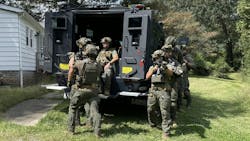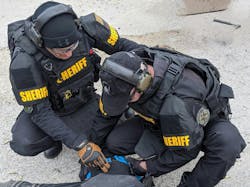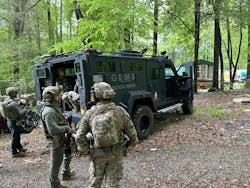Police Tactical Medics Talk About Working in the Line of Fire
Kristopher Gent has been a tactical medic long enough to remember when tourniquets were considered taboo and he couldn’t carry a gun on the job. Now he’s trained to use both in the field. He’s also been a tactical medic long enough that other agencies seek him out for advice on how to create those positions.
This article appeared in the March/April issue of OFFICER Magazine. Click Here to subscribe to OFFICER Magazine.
“I was joking not too long ago, if I was smarter, I probably would have got out of this a long time ago,” he says. “I’m sure my wife would probably appreciate if I didn’t keep doing it. I know every time I go out the door on one of these calls, there’s always a little bit of worry of what could happen.”
The Green, Ohio, Fire Department battalion chief is part of a growing position in SWAT units that bridges law enforcement and the EMS and fire service. OFFICER Magazine spoke to officials from three agencies about their tactical medic teams, from the roles they serve to allowing members to carry guns.
Green, Ohio
Gent was at the ground floor when the Green Fire Department created its tactical medic unit. In 1998, the Green County Sheriff’s Office—which contracts law enforcement service with the city—was restarting its SWAT unit, and it was thought a medical component would be needed, “which, at the time, was kind of forward-thinking,” says Gent.
“The original thought was just send one of the deputies to EMT training, and that would be their medical support,” he says. “The fire chief was a part-time deputy. He realized that if you took a deputy, trained him on the medical side, it might be kind of hard to maintain the proficiency on the medical side if you’re not doing it every day. But also if you have a small team and now you take one of those operators, and they have to treat another operator, you’re down a minimum of two. So he said, ‘Hey, I’ve got paramedics. Why don’t we let the paramedics be paramedics? We’ll let the deputies be operators, and we’ll kind of form this team together. And that’s how we all started.”
Since that time, Gent has seen the program evolve into the 10-member team it is today. Medics train eight hours a month with the SWAT team. Applicants are chosen not only for their particular skills as a paramedic, but the ability to thrive in different kinds of high-pressure situations.
“We’re also looking for that paramedic that can think outside the box and kind of react under pressure,” says Gent. “We have one paramedic that years and years ago applied. He’s a very good medic, back of the ambulance. And if you’re supposed to do A, B then C, he’ll get that done. But he’s a type of guy that if you have to go from A to D, you might get a little hung up, because our medical protocol says we have to do this, then this and this.
“That’s in the back of an ambulance. That’s not in a front room of a house where a deputy just got shot coming through the front door. We might have to go from A to D and then get out of there.”
That shift in thinking extends to how tactical medics treat those injured in the field. As a paramedic, Gent would assess patients to possibly have them transported for further treatment. As a tactical medic, he tries to find the best way to keep a deputy in the fight if possible.
“Probably one of the (incidents) that jumps into my mind, not a significant injury, but it showed to me the value of having immediate medical care … I was assigned to deputies on the backside of a building that were breaching an upper door off of like almost like a deck, and the deputy that was breaching, … he followed through with the ram and ended up hitting his hand on the door frame and busted open his hand and started bleeding,” says Gent. “For a brief second, he’s out of the fight. He’s bleeding. He’s injured. I was able to pull him aside, wrap his hand quickly and send him back in to finish the mission.”
It was an example that because the medics were so closely embedded with them, instead of him having to drop out of the fight, we were able to quickly patch him up, let him finish his job, support the other deputies on the scene, and then we could get him proper medical care,” he adds.
Ohio is one of the states that allows tactical medics to carry a gun for self-defense during SWAT assignments. Gent admits it’s a big responsibility, but the 40-hours of state-mandated firearms training helps prepare the paramedics with the proper skills and mindset.
“It’s not a matter of being cool or, hey, look at me. I can carry a gun now. I’m a fireman, and I can carry a gun,” he says. “It’s recognizing what that really means, that if you’re in a situation where you have to draw that weapon, that there’s a chance you may have to take someone’s life. … You want to make sure you have the training, that you can recognize a threat properly and address that threat as needed.”
Pasco County, Florida
Pasco County Fire Rescue hasn’t had nearly the history with tactical medics that the Green Fire Department has. The fire service agency in the county just north of Tampa initially set the wheels in motion for a group of tactical medics to work with the Pasco County Sheriff’s Office’s SWAT unit in early 2023. By December, the first members attended a mini-SWAT training school, and in February, Deputy Chief Shawn Whited received the first call in which tactical medics were needed.
“This was a high-risk search warrant that was going to be served at three in the morning, so we had prior acknowledgement of the SWAT call out,” Whited tells OFFICER. “For our first time going out and putting our paramedics in body armor and armored vehicles with their issued agency weapons and stuff, to be able to put them out in somewhat of a controlled call out was really reassuring.”
That first call ended up being the best kind of calls: uneventful. Medics weren’t needed, but deployment went smoothly. In fact, Whited was impressed with how seamlessly the agency’s medics meshed with the SWAT unit. Not only did the medics post at the SWAT unit’s command center and keep track of warrant execution via a live drone feed, but they also were brought in at the planning stage.
“Our guys that were with them were just like part of their team, like just integrated perfectly with them,” he says. “So to have that type of a first call out was really nice.”
The cooperation Whited saw on that first mission illustrates the “really great relationship” the fire agency and the sheriff’s office have, something that hasn’t always been the case. Although tactical medics are a recent addition, the two agencies had talks on and off over the years of creating the positions, but nothing could get hammered out until last year. The agencies’ increased closeness has bled through in other areas, too.
“They called us at the very onset and gave us a heads up and said, ‘Hey, we might have a barricaded subject, and he’s threatening to blow his house up, and he’s dumping gasoline all over his house, and he’s got propane tanks set up. … Can you send someone over to help in our planning cell?’” says Whited.
“They called us early, (and we) were able to get in there early,” he adds. “The sheriff’s office doesn’t know what the fire rescue capabilities are, and when you get a bunch of police officers in a room, they think up some crazy stuff. And one of their ideas was to attach a fire hose to the end of a battering ram and drive it through the wall of a house. I told them, that’s not a good idea. We’re not going to do that. So we came up with a different game plan that we have the expertise in, and they were like, ‘Oh, well, that actually makes more sense.’ And I’m like, ‘Right, you guys shoot the bad guys. We’ll put the fire out.’ … It’s really kind of united the two agencies to be on a better playing field.”
Like Ohio, Florida allows tactical medics to carry guns in self-defense, and it’s a privilege given to those in Pasco County. Whited says that officials did have initial talks about not arming tactical medics, but it was ultimately determined to allow them to carry guns to protect themselves. And just as important was making sure medics were legally protected, he adds.
“That was our biggest thing, we wanted to protect our members of the fire service, because ultimately, at the end of the day, they’re still they still work for the fire department. We wanted to make sure that they were well-protected. And like I said, through our agreement with the sheriff’s office and working with their attorneys and the county’s attorneys, we were able to come to a really good, solid understanding of how, God forbid, something should happen, whose responsibilities are where. And we’ve laid all that out, so we’re all on the same page.”
Currently, Pasco County has 16 tactical medics, but Whited says the goal is 22. When he thinks about the program’s future, Whited envisions more buy in and interest from those within the agency. That’s something he knows takes time, but now that the program is underway, he’s already seeing it grabbing the attention of a few of his colleagues.
“We had our first actual call out the other night, and since that call out, I’ve had three firefighter/paramedics that called me and said, ‘Hey, I didn’t know this was really going to happen.’ Well, we’ve sent out emails. It’s happening. We told you it’s happening. So now we have three more guys that are going to start going through the process.”
Gaston County, North Carolina
Between the two of them, Gaston County EMS Deputy Chief Jamie McConnell and Capt. Bill Mitchell have roughly 55 years of EMT experience. Their agency created a tactical medic program in 2000, and Mitchell was in one of the first groups to go through training in 2002, while McConnell joined in 2004. The job even lured Mitchell out of briefly retiring after 30 years of service to serve part time and oversee the team.
"It’s like my way to come back and still be able to do something and take things off of other people’s plates, because we’re not so busy that it’s a full-time position. … It’s a good part-time position,” he says. “Sometimes it pushes the envelope of being a little more than part time. But we seem to manage. We work well together.”
Along with the on-scene support during high-risk warrants and other SWAT calls, Mitchell and McConnell see the role of the tactical medic as a “medical conscience” for team commanders. While SWAT members are focused on devising the best way to breach a house, the tactical medical team creates a plan to keep everyone involved alive.
“We bridge the gap for all the other emergency services because they have a tough job,” says McConnell. “They’re trying to address a threat, so we kind of have to step back and think about everything else, think about the well-being of not only the officers, but whatever victims we may have in the house or even the neighborhood, the surrounding neighbors and everybody else that could be involved.”
Keeping team members safe also includes keeping the medics protected. North Carolina is not a state that allows its tactical medics to carry guns (a bill passed the House but died in the Senate). The agency, however, is exploring other avenues to arm its tactical medics, says McConnell. County lawyers are exploring a North Carolina Office of Emergency Medical Services administrative rule that allows medics to carry a weapon.on a truck specifically for tactical medic call outs as long as it’s locked and in a safe out of the patient compartment. Another option could be to swear in medics as volunteer deputies.
“I would hope within the next three months we would have all the policies done and approved and be able to start walking through the initial steps for (arming) one or two medics and doing the proof of concept,” says McConnell.
Although it comes with its own unique stresses and dangers, the job of tactical medic can share the same sense of satisfaction and disappointment as that of a non-SWAT paramedic. McConnell and Mitchell have both responded to calls that have ended with everyone going home, as well as those in which everyone wasn’t that fortunate.
We had a fairly high-profile case that we ended up losing a child,” says Mitchell. “The team ended up saving a child, but they also lost a child. That one, it’s still kind of fresh. I was glad I was there to help some officers that were injured. I was glad I was there to help one of the children that survived. … So even in that one call there, there’s things I’m glad I was there for, and things I wish I could forget.”



